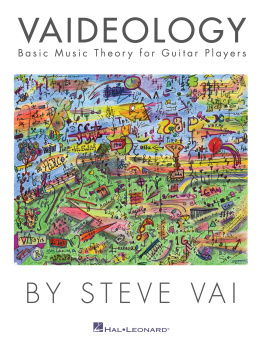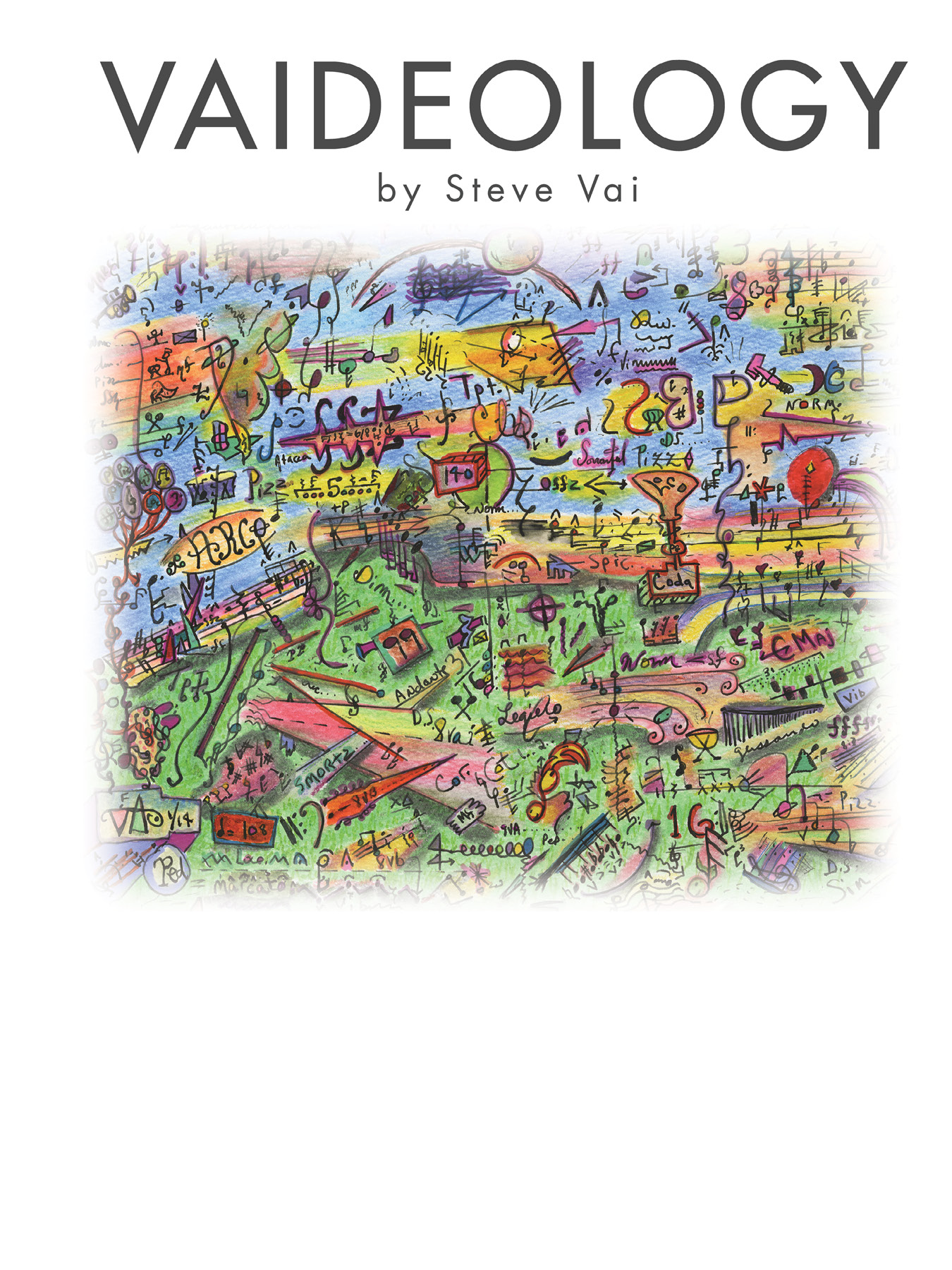Print ISBN: 978-1-5400-3099-3
ePub ISBN: 978-1-5400-4777-9
Kindle ISBN: 978-1-5400-4778-6
All illustrations by Steve Vai
Copyright 2019 SyVy Music (ASCAP)
International Copyright Secured All Rights Reserved
No part of this publication may be reproduced in any form or by any means without the prior written permission of the Publisher.
Visit Hal Leonard Online at
www.halleonard.com
Contact us:
Hal Leonard
7777 West Bluemound Road
Milwaukee, WI 53213
Email: info@halleonard.com
In Europe, contact:
Hal Leonard Europe Limited
Wigmore Street
Marylebone, London, W1U 2RN
Email: info@halleonardeurope.com
In Australia, contact:
Hal Leonard Australia Pty. Ltd.
Lentara Court
Cheltenham, Victoria, 3192 Australia Email: info@halleonard.com.au
ACKNOWLEDGMENTS
INTRODUCTION
Intellectual Understanding vs. Experiential Knowing
NOTES ON THE NECK (ACADEMIC STUDY)
Accidentals
Enharmonic Tones
Guitar Fretboard Notes
NOTES ON THE NECK (EXPERIENTIAL STUDY)
Listen Intensely
Note Recognition Exercise
NOTES (ADVANCED)
Microtones
Comprehensive Accidentals List
Advanced Note Recognition
SCALES (ACADEMIC STUDY)
G Major Scale
Intervals
Compound Intervals
Interval Table
SCALES (EXPERIENTIAL STUDY)
Listening
G Major Chord Progressions
ADVANCED INTERVALS (EXPERIENTIAL STUDY)
SCALES CONTINUED (ACADEMIC STUDY)
The Minor Scale
G Minor Scale
G Minor Chord Progressions
Pentatonic Scale
G Major Pentatonic Scale
Blues Scale
G Blues Scale
Practicing Scales
Exploring the Neck
G Blues Scale + B b Major Pentatonic Scale
Whole-Neck Awareness in G Blues
G Blues Scale + B b Major Pentatonic Scale Expanded
Make Every Note Work, Somehow
KEY SIGNATURES AND THE CIRCLE OF 5THS
Sharp Keys
Flat Keys
Relative Major and Minor Keys
Circle of 5ths
NOTES ON MANUSCRIPT (ACADEMIC STUDY)
Staff
Grand Staff
CLEFS (ADVANCED)
Percussion Clef
Various Percussion Staves
TRANSPOSING INSTRUMENTS
Guitar Transposition
Non-Transposing Instruments
Transposing Instruments
MUSICAL NOTES
CHORDS (ACADEMIC STUDY)
CHORDS (EXPERIENTIAL STUDY)
CHORD SPELLING (ACADEMIC STUDY)
Chord Spelling Library
Chord Symbol Dictionary
CHORD SPELLING (ADVANCED STUDY)
Close Voicing
Open Voicing
Chord Inversions
CHORDS (EXPERIENTIAL STUDY CONTINUED)
WRITING MUSIC (ACADEMIC STUDY)
Note Values
POLYRHYTHMS
CONTENTS
POLYRHYTHMS (ADVANCED)
Tuplet Terminology
POLYRHYTHMS (EXPERIENTIAL STUDY)
TIME SIGNATURES (ACADEMIC)
Common Time: 4/4 Meter
Waltz Time: 3/4 Meter
March Time: 2/4 Meter
Duple, Triple, Quadruple, Simple, and Compound Meter
Meter Chart
Complex (Odd) Time Signatures
TIME SIGNATURES (ADVANCED)
Composite Meter
Poly-Meter (or Poly-Metric)
GUITAR TABLATURE
Guitar Tab
GUITAR TAB ARTICULATION AND ORNAMENTATION
COMPOSING MUSIC
Tempo
Tempo Alterations
Tempo and Metric Modulations
Repetition Signs
Articulations
Note Articulations
Dynamics
Dynamics Chart
Dynamic Accents
COMPOSING MUSIC CONTINUED
Crescendo
Decrescendo
Octave Sign
GUITAR HARMONICS
Natural Harmonics
Artificial Harmonics
READING GUITAR RHYTHM
RHYTHM (EXPERIENTIAL STUDY)
THE GROOVE
CHORD SCALES (ACADEMIC STUDY)
CHORD SUBSTITUTIONS
MODES (ACADEMIC STUDY)
Modes Table with Chord Scales
MODAL PROGRESSIONS
Ionian Mode (Major Scale): First Mode of the Major Scale
Dorian Mode: Second Mode of the Major Scale
D Dorian Mode (Eighth Position)
Phrygian Mode: Third Mode of the Major Scale
E Phrygian Mode (10th Position)
Lydian Mode: Fourth Mode of the Major Scale
F Lydian Mode (Open Position)
Mixolydian Mode: Fifth Mode of the Major Scale
G Mixolydian Mode (First Position)
Aeolian Mode: Sixth Mode of the Major Scale
A Aeolian Mode (Third Position)
Locrian Mode: Seventh Mode of the Major Scale
B Locrian Mode (Fifth Position)
Additional Chord Tensions
OTHER SCALES
Harmonic Minor Scale
Harmonic Minor Modes
Melodic Minor Scale
Melodic Minor Modes
Diminished Scale
Altered Scale
Even More Scales
Hexatonic Scales
Pentatonic Scales
IN CLOSING
ACKNOWLEDGMENTS
Big thanks go to all the phenomenal music and life mentors Ive had throughout my career: Bill Westcott, Joe Satriani, Wes Hensel, Joe Bell, Mike Metheny, Frank Zappa, and David Lee Roth.
And sincere thanks to all the campers that have joined the Vai Academy retreats. I learn so much from all of you, and this document was originally written for you.
Thanks also to Jason Henke for his editing, Jay Graydon for his insight, and special thanks to Cory McCormick for finding all my errors.
INTRODUCTION
In short This document is a guide to the fundamentals of music theory for the aspiring guitar player.
In long Do you need to know music theory to be a good musician? Thats one of the commonly asked questions I hear when speaking to aspiring guitarists. It seems to be a source of confusion and concern for many. Heres something to ponder: whatever you are interested in, you will naturally seek out to understand because you are interested in it. If you find yourself fascinated with understanding the language of music, nothing will stop you from seeking it out and making it part of your musical vocabulary.





























